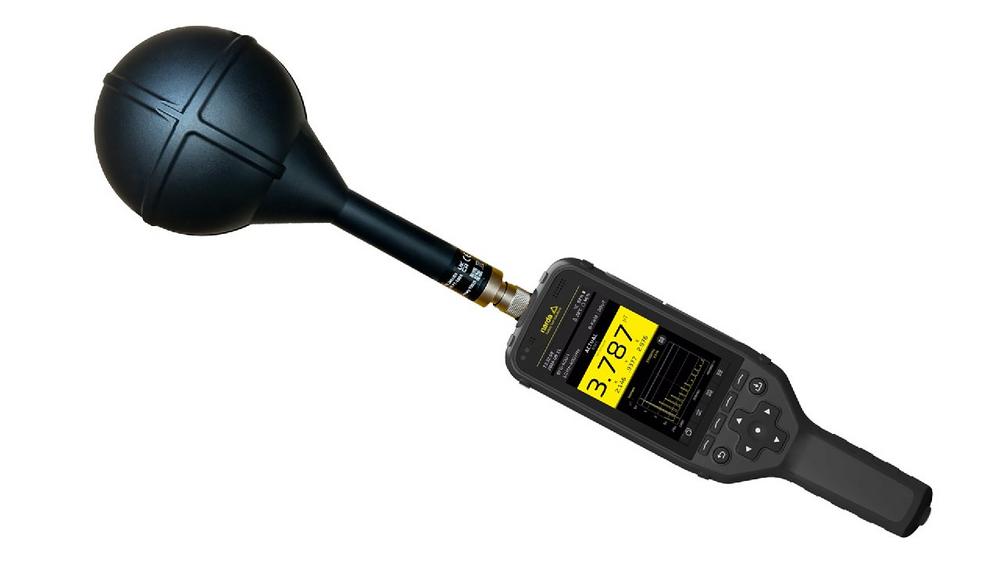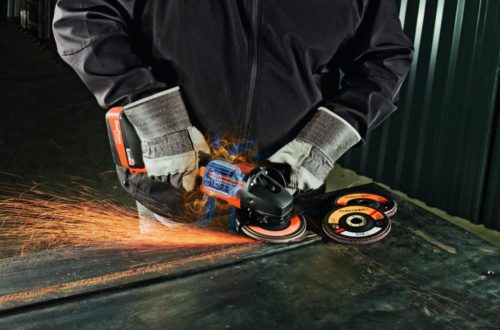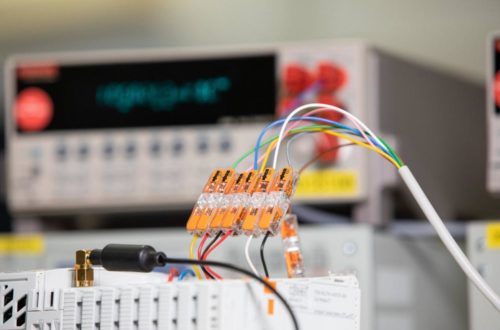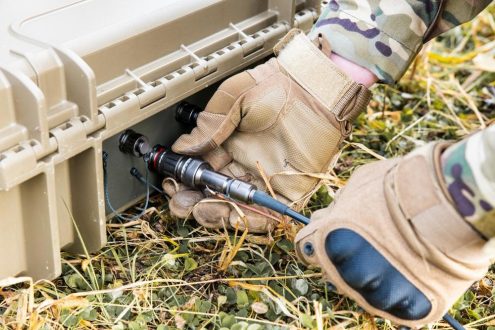
Narda’s FieldMan Probe BFD-400-1: The New Way to Analyze Magnetic Fields
Together with the compact EHP-50F Probe, the frequency-selective FFT field analyzer for isotropic measurement of electric and magnetic fields, which can now also be used with the FieldMan, they both cover the entire low-frequency range for workplace safety applications. The probes automatically evaluate the exposure levels in accordance with the major standards such as EU Directive 2013/35/EU, ICNIRP or IEEE, while the FieldMan indicated the exposure level index directly as a percentage of the limit value for the selected standard.
A new situation
Reliable evaluation of low-frequency field sources in terms of workplace and public safety places heavy demands on both the measuring equipment and the interpretation and analysis of the captured signals, particularly in the industrial setting. This is often because the field conditions are becoming ever more complex. But, even generally speaking, the area of EMF safety is rapidly increasing in importance as a result of new global trends. As well as in the heating industry and motive power sector (think electromobility), the electrification of large industrial processes such as steel production using electric arc furnaces is increasingly replacing processes that were previously based on the use of fossil fuels.
LF and HF in one instrument
The newly developed BFD-400-1 probe is seamless addition to the matchless success story of the ELT-400 from the market and technology leader for professional electromagnetic field (EMF) test equipment. For some fifteen years now, Narda’s reference instrument for the low frequency range has been the benchmark for EMF safety measurements, with more than 2,000 units sold. Now the ageing ELT-400 is to be replaced by the innovative BFD-400-1, which now enables the FieldMan to indicate both low- and high-frequencies across the range from 1 Hz (DC) to 90 GHz in a single measuring device without any compromises. In contrast with the simple evaluation of the field exposure made by the ELT-400, the BFD-400-1 additionally displays the signal spectrum and can resolve it into its separate spectral components to give details of its exact composition.
BFD-400-1 applications
This new development from the Pfullingen-based test equipment specialist is aimed squarely at all stakeholders, public authorities, institutes, service providers and authorized agents in the field of workplace safety who are concerned with standard-compliant monitoring of the current international standards covering safety in low-frequency magnetic fields, such as EU Directive 2013/35/EU, ICNIRP, IEEE or CENELEC. The typical measurement environments include: industrial production areas such as induction heating and smelting; electric welding equipment; the railroad industry; electrical medical equipment; energy supply systems; and the automotive sector. In particular, e-mobility has opened up a whole new field of applications that, as well as EMC measurements, includes investigating the localized field exposure of persons seated in electric vehicles using several specially positioned measuring probes.
Technical achievements
The newly developed BFD-400-1 takes care of calculating the measured values within the probe in addition to capturing the measurements in the same way as all the digital probes for the FieldMan. The active components required for processing the measured values are actually contained in the connector of the probe itself. The digital probe from Narda STS can therefore be used without the basic unit. This unique feature has several key advantages.
Increasingly, customers are demanding the use of measuring equipment with accredited calibration, particularly for sensitive measurements in the field of EMF safety, where human safety is involved. Since only the BFD-400-1 without the basic unit needs to be sent for calibration, technicians can continue to use their FieldMan devices with other probes while calibration is being carried out. They can therefore take on further tasks and avoid costly down times.
Standalone use of the BFD-400-1
Additionally, the digital probes from Narda STS can be used with a PC or laptop with the corresponding software option without using the FieldMan. This allows users to employ several probes simultaneously, such as is commonly done for EMC measurements in the automotive industry or in large production facilities, without needing to purchase a separate basic unit for each probe. And, last not least, by processing the signal within the probe itself Narda STS has avoided a potential safety weakness that is common to plug or screw-in connectors when signals are transmitted. Here it is only the measurement result and not the received signal that is transmitted digitally to the basic unit.
The standard-compliant 100cm2 sensor
The actual probe used is a 100cm2 sensor that precisely captures the field strength isotropically, that is, regardless of the angle of incidence of the electromagnetic field. Exact knowledge of the field under investigation and of the measuring equipment used is generally required in order to correctly evaluate the exposure caused by low-frequency fields. This is because the applicable limit values depend on the predominant frequency of the field. The BFD-400-1 therefore utilizes the frequency response weighted measurement methods of Weighted Peak or Shaped Time Domain (STD) to analyze the signals in the time domain. The latter method greatly simplifies everyday measurements even for inexperienced test technicians, as it automatically takes account of the dependency between frequency and limit values. The method is basically split into WPM (Weighted Peak Magnitude) and WRM (Weighted Root Mean Square). While WPM is well-suited to capturing peak effects, WRM gives users a better idea of the average overall exposure levels.
Just one probe for all standards
Previously, technicians were restricted to a specific standard when using the ELT-400. This was because the question of differing standards was resolved by means of a different hardware filter in each case. This is now a thing of the past. The BFD-400-1 is equipped with downstream digital filters that resolve the question of the standard by means of software. This means that users can now use just one probe to make measurements that comply with several standards, such as ICNIRP, FCC, DIN EN 50413 VDE 0848 or EU Directive 2013/35/EU.
Functionalities
When combined with the FieldMan, the BFD-400-1 can be used to make simple measurements as well as very detailed ones. In the first instance, all that is needed is to switch on the basic unit and read off the result shown on the display as a percentage of the standard limit value. Reliable, dependable standard-compliant workplace measurements can be made at the press of a button rather than needing the services of highly specialized expert test engineers. If detailed results of the recorded signal are required, the three orthogonally and concentrically aligned coils in the BFD-400-1 also deliver a precise three-channel real time analysis up to 400 kHz, with the results displayed in both the time and the frequency domain. The probe measures magnetic fields omnidirectionally and can be positioned easily and precisely, thanks to the geometric arrangement of the probe coils.
Voltages proportional to the time derivative of the magnetic flux density are induced in each of the three coils. The entire signal processing for the measurement in the time / frequency domain takes place in the probe. Correct-phase evaluation procedures with peak or RMS detectors can be applied in the time domain, and the measured value is transmitted digitally to the FieldMan or a PC via the USB probe connector.
BFD-400-1 operating modes
The BFD-400-1 has six operating modes, starting with Field Strength, Spatial Average (measures the spatial average of the field strength across several points distributed in a space), and Timer Logging (measures field strength continuously or at regular intervals over a defined time period). In Spectrum/Real Time FFT mode, the new probe can resolve and analyze the individual frequency components of the electromagnetic field in real time. Shaped Time Domain mode allows test technicians to record the signals in the time domain including any frequency-dependent weighting (shaping) required by the particular standard. Scope mode enables visualization of the development of a magnetic field in the time domain without the need for an external oscilloscope. Finally, technicians can use the BFD-400-1 in Raw Data Streaming mode to continuously capture unprocessed raw data in real time and transfer it to an external system such as a PC or a data logger.
More innovations from Narda STS
– FieldMan app
The FieldMan app allows test technicians to visualize, live track and even remotely control measurements in progress from their smartphone via WLAN link at distances of up to 30 meters depending on environmental conditions. All the measurement results are reproduced 1:1 on the smartphone screen. The app also provides numerous other features such as screenshots, taking photos or videos of measurement situations that can then be allocated to different measurement projects to make the production of test reports much easier and more efficient.
– TSX (software) Live Measurements Option
The Live Measurements option enables live measurements while simultaneously adding the functions of the FieldMan to the TSX software. It enables direct operation of a probe from a PC connected by a USB cable without the need for the FieldMan itself (analog probes require the use of the A/D Probe Converter). The optical connection can also be utilized via the Digital Broadband Probe Repeater, allowing operations in EMC laboratories, for example. The FieldMan can also be remotely controlled using this option.
– Digital Broadband Probe Repeater
The Digital Broadband Probe Repeater converts the digital electrical signal into an optical signal and transmits it to the FieldMan through a fiber optic cable. This allows safe, reliable measurements, for example on high-field radar at extremely high fields strengths without interference at distances of up to 50 meters.
– A/D Probe Converter
The Analog Digital Probe Converter makes it possible to continue using NBM probes with the FieldMan. The A/D Probe Converter converts the analog signal from the NBM probes into a secure digital signal, which is then processed directly in the converter.
Coming soon
– BFD-400-3
The new BFD-400-3 Probe (3cm2 probe) will be released early 2025. This probe is used to determine the coupling factor according to IEC/EN 62233. It is designed for localized strongly varying magnetic fields and can therefore be used to localize the sources of magnetic field interference, such as in control cabinets.
Narda is a leading supplier of measuring equipment for EMF Safety, RF Test & Measurement and EMC. The EMF Safety product spectrum covers broadband and frequency-selective measuring devices and monitors for wide area coverage, as well as wearable warning devices for personal safety. The RF Test & Measurement range includes analyzers and devices for the measurement and identification of RF sources. The EMC sector offers instruments for determining the electromagnetic compatibility of devices under the PMM brand name. The range of services provided includes servicing; calibration, including accredited calibration; and continuous training programs. The company operates a management system that complies with ISO 9001:2015 and maintains a calibration laboratory that is accredited to DIN EN ISO/IEC 17025:2018.
Narda has development and production facilities in Pfullingen / Germany and Cisano / Italy, and has its own representative in Beijing / China. A worldwide network of representatives guarantees closeness to customers.
Narda Safety Test Solutions GmbH
Sandwiesenstr. 7
72793 Pfullingen
Telefon: +49 (7121) 9732-0
Telefax: +49 (7121) 9732-790
http://www.narda-sts.com
Redakteur|Inhaber
Telefon: +49 (7522) 9899850
E-Mail: thomas.jungmann@texterei-jungmann.de
Marketing Manager
Telefon: 071219732518
E-Mail: anja.kuehne@narda-sts.com
![]()




